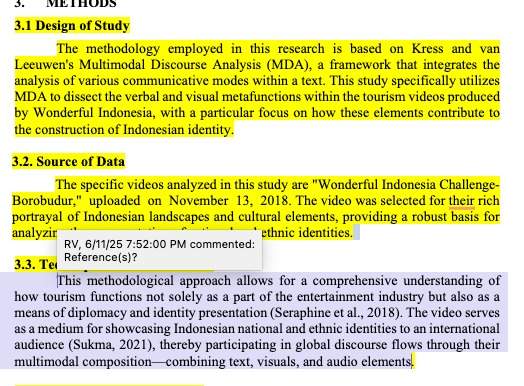I made this guide to assist me when editing the SiELE articles.
This is an additional guide to the standard one provided by the journal.
Most of the guides are recommendations made by Prof. Yunisrina.
DAFTAR ISI
1. Primary vs secondary source
If the original work was published more than 20 years, the secondary source is acceptable. If otherwise, editors are encouraged to comment on the article.
Example of the comment: “Cite the original Lazar’s work if the work was published in the last 20 years.”
2. Uncommon proper noun:
If the author capitalizes uncommon proper nouns such as the name of approach and method un-uniformly, editors need to comment on the article asking the author to make necessary changes.
Example of the comment: “The use of capitalization is not uniform throughout the article when referring to some approaches. Ensure consistencies throughout the article.”
3. Incorrect DOI:
Ensure that all DOI in the reference list is correct. If the DOI used in the reference list is incorrect, provide the correct one.
4. Non-APA 7th:
Check if all references are formatted in APA 7th, if only three to four references are formated incorrectly, editors are encouraged to correct the format. If otherwise, comment on the article.
Example of the comment: “Some of the references does not follow in APA 7th, format the reference list in APA 7th.”
5. Citation tenses.
The verb used when citing work is simple present while the verbs inside the citation vary. If it is the definition, the verb is simple present; if results, the verb is in simple past.
Example of correct in-text citation: “Zainuddin (2018) says that students who have good learning strategies often excel in speaking, and this is as found in his research conducted on ESL Indonesian at the high school level.”
If the mistakes are too many, editors may comment on the article.
6. Do not edit excerpts from the interview.
Leave any errors from the interview’s excerpt as is. No revision is necessary for this part.
7. Keywords need to be in alphabetical order
Make sure that the keywords are in alphabetical order or comment on the article for the author to do so.
Example of the comment “Present the keywords in alphabetical order“
8. Affiliatoin on the first page
Make sure that the affiliation information follows the Siele model or comment on the article for the author to do so.
Example of the comment “Please complete the affiliations; see previously published articles in SiELE journal for examples. Each affiliation should include the department, faculty, university, city, post code and country“
9. The use of italics in the article
Only non-English words are italicized while words in focus should be placed in the single quotation mark ‘…’
Example of the comment “Italics are only for non-English words. For words in focus (in English), they can be presented in ‘…’ (single quotation marks). Please make corrections throughout your paper.“
Foreign words and phrases used in an English text should be italicised (no quotation marks or inverted commas) and should have the appropriate accents:
EXAMPLE: acquis, carte blanche, raison d’être, gezellig, hygge
AVOID: ‘hygge’ (inverted commas)
APA Style – Requires italics for non-English words, phrases, and abbreviations if they may be unfamiliar to readers, but only on the first use. – Knowdays
10. Exceprt interview
Excerpts from interviews (and textbook) should be numbered consecutively in the Results section. The font size for these excerpts should be set to 9 in Times New Roman.
Example of the comment “The font size for these excerpts should be set to 9. Please make corrections throughout your paper.“
11. Comment for missing reference list in citation
Example of the comment “This citation does not appear in the reference list. Please add the full reference to the list or delete the citation from the text.“
“The following references are not cited in the text. Please ensure they are properly cited or remove them from the reference list.
Christie, F. & Derewianka, B. (2008)
He, Q. (2020)
He, Q. (2022)
Yang, Y. (2013)”
12. Overall comment in the title
- Reformat the article to comply with the author guidelines in the updated SiELE Template 2025+.
- Do not delete editor comments; instead, reply to them or mark them as resolved after making the necessary revisions.
- Highlight all revisions in green for clarity.
- Reinsert the author’s name, affiliations, and corresponding email as per the SiELE 2024 template.
- Submit the revised article by date monht.
13. Comment for fontsize
Font size for Table “Ensure that the font size for all tables complies with the updated SiELE Template 2025+: 11 for titles and 9 for content.”
“Ensure that the font size for headings and content complies with the updated SiELE Template 2025+: 11”
The word table when referred in the text should be Capitalized
13. A par. that may be less than 3 sentences.
Intro to headings

Intro to excerpt

Long par. but less than 2 sentences should be devided

